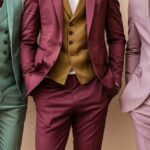Not sure what business casual means? You’re not alone. It’s about looking professional without the formality of a full suit and tie. Getting it right boosts your confidence and avoids dress code mistakes. With the right clothes and accessories, you can look polished and feel comfortable all day. Keep reading to learn what business casual is, how it varies, and how to master it easily.
What is Business Casual?
Business casual is a neat and professional style that balances formal and casual clothes. It’s less strict than a full suit and tie but still looks polished. Men usually wear dress pants or chinos with a button-up or polo shirt, while women often choose slacks or skirts with blouses or cardigans. Jackets and blazers are optional for both. The key is to look tidy and professional while staying comfortable enough for everyday work.
Business Casual Ideas
For Men
Wear chinos or dress pants with a collared shirt. Add a blazer or sweater if it’s cool. Avoid jeans, sneakers, and T-shirts.
For Women
Try a knee-length skirt or dress pants with a blouse or sweater. Choose closed-toe shoes. Skip tight, short, or flashy clothes.
Footwear
Go for loafers, flats, or simple heels. Avoid sandals, flip-flops, and athletic shoes.
Accessories
Keep it simple with a watch or small jewelry. Avoid bright colors and big logos.
Defining Business Casual by Industry
Tech and Creative Jobs
These workplaces are usually relaxed. Clean jeans, casual shirts, and sneakers are often okay—as long as everything looks neat and put-together.
Finance and Legal Fields
These jobs stay close to formal. Business casual here means dress pants, tucked-in shirts, and often a blazer. Keep colors simple and your look sharp.
Education and Healthcare (Office Roles)
Comfort matters, but you still need to look professional. Polo shirts, sweaters, and khakis work well. Avoid loud styles or anything too casual.
Understanding Workplace Dress Codes
Knowing the dress code rules at work helps you avoid mistakes and dress right every day.
Check the Dress Code Policy
Always check your company’s official dress code policy or employee handbook. If unsure, ask HR or your manager for guidance. Dress codes can be written clearly or sometimes unspoken expectations.
Decode the Dress Codes
Business Professional
Formal and traditional. Men wear suits, ties, and dress shoes. Women wear tailored suits, modest dresses, or blouses with dress pants or skirts. Stick to neutral colors and polished looks.
Business Casual
Neat but relaxed. Men can wear dress shirts with chinos—no tie needed. Women can wear blouses, cardigans, or simple dresses. Avoid jeans, sneakers, and anything too casual.
Smart Casual
Stylish and flexible. Think clean jeans or chinos with a blazer or nice shirt. For women, a mix of casual and tailored pieces works well. It’s polished without being too formal.
What Not to Wear at Work
To keep your business casual look professional, avoid these common mistakes:
T-Shirts, Hoodies, and Athletic Wear
These items are too relaxed for most workplaces. Even if your job is casual, it’s better to wear a collared shirt, blouse, or knit sweater. Avoid anything that looks like gym clothes or weekend loungewear.
Jeans or Distressed Pants
Unless your office dress code clearly allows it, stay away from jeans—especially those with rips, fading, or a tight fit. Choose dress pants, chinos, or skirts that are neat and structured.
Casual Footwear
Sneakers, sandals, flip-flops, and flashy shoes don’t belong in a business casual setting. Instead, wear clean, closed-toe shoes like loafers, flats, or oxfords that match the tone of your outfit.
Loud, Flashy, or Revealing Styles
Clothing that’s too bright, tight, short, or heavily patterned can feel distracting or unprofessional. Stick to neutral colors, modest fits, and simple designs to keep your look polished and respectful.
Additional Tips for Business Casual Attire
- Fit matters: Clothes should fit well—not too tight or too loose.
- Layer smart: Adding a blazer, cardigan, or sweater can elevate your look.
- Colors: Stick to neutral or muted tones like navy, gray, black, white, and beige for versatility.
- Shoes: Invest in a couple of pairs of good-quality shoes that are both comfortable and stylish.
- Grooming: Neat hair and clean nails are part of business casual too.
- Adapt for your role: Some jobs require more formal dress, so always adjust based on your daily tasks or meetings.
- Keep it simple: Avoid flashy logos or slogans. Your clothing should help you look professional, not distract.
Mastering the Business Casual Look
Understanding the casual business dress code policy helps you look confident and professional while staying comfortable. Always check your workplace’s specific guidelines and tailor your outfit to your industry’s norms. Avoid common mistakes like overly casual clothes or poor grooming to make the right impression. With the right choices, you can navigate business casual with ease, confidence, and style.




Leave a Reply